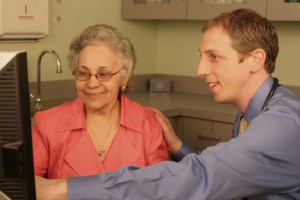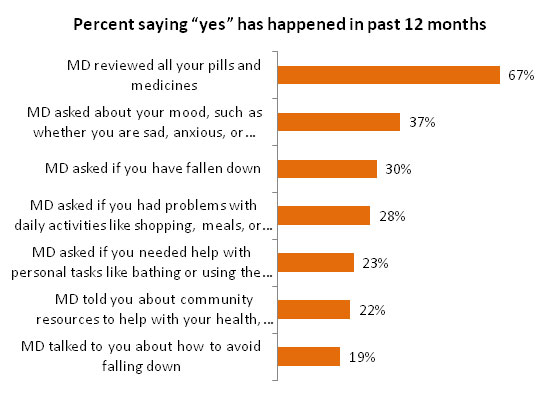 If we want to improve primary care for older adults, we need to know something about their primary care experiences. To find out, we commissioned our first poll, with help from Strategic Communications & Planning, called “How Does It Feel? The Older Adult Health Care Experience.” Between February 29 and March 3, 2012, Lake Research Partners surveyed 1,028 adults age 65 and older about their satisfaction with their primary care provider and whether or not their care included recommended services for older adults.
If we want to improve primary care for older adults, we need to know something about their primary care experiences. To find out, we commissioned our first poll, with help from Strategic Communications & Planning, called “How Does It Feel? The Older Adult Health Care Experience.” Between February 29 and March 3, 2012, Lake Research Partners surveyed 1,028 adults age 65 and older about their satisfaction with their primary care provider and whether or not their care included recommended services for older adults.
It turns out that the vast majority of older adults are at least somewhat satisfied with their care. But when you ask them specific questions about the care their doctors are providing, it becomes apparent that this satisfaction may be based on a lack of knowledge about what constitutes good care. We asked respondents about whether or not they had received seven recommended medical services that are typically part of a geriatric assessment (see below).

Even though these low-cost, low-tech practices can prevent health problems, decrease health care costs, and even prevent death, they are rarely used. Only a tiny number (7%) of older adults surveyed received all seven recommended services, more than half (52%) reported receiving none or only one, and a vast majority (76%) received fewer than half the services.
Here are some other important specifics:
- The only recommended service that most older adults get regularly is a medication review—and almost one in four aren’t even getting that.
- Only 19 percent received information about how to avoid falls. Yet falling causes 90 percent of all hip fractures and is the leading cause of injury and injury-related death in older adults.
- Only 37 percent of respondents reported that their doctors checked for depression, even though older adults are at a greater risk of suicide than any other age group. Depression also exacerbates chronic diseases like diabetes and heart disease.
We need to do better. What we learned from this poll is not only do we need to better educate providers about geriatric assessments, we also need to help the public understand what good medical care for older adults should look like. One opportunity may be the new Medicare Annual Wellness visit. Because this visit is focused on preventing future disease, it is the perfect venue for primary care providers to conduct a geriatric assessment. Plus, it pays doctors nearly three times as much as a regular visit and is completely free for older patients (no co-pays or deductibles). Yet over half (54%) of respondents had never heard of the annual wellness visit, and only 17 percent reported getting the visit. The actual number may be even lower—Medicare’s own records suggest that only 6.5 percent of Medicare recipients use the benefit.
We have an opportunity here. While data and research are important (see other posts on alarming data here and here, the voices of older adults themselves are incredibly powerful. At the end of the poll, we asked our older adult respondents if they thought that health care professionals should have more training in caring for older people, and 93 percent said yes. Even more significantly, after thinking through our questions, 67 percent said they believed they themselves would get better care if their providers were more knowledgeable about caring for older adults.
Let’s share this information widely. Post it to your websites and share it in your newsletters. Talk to your local media about the issues and how your work is helping to better manage medications, prevent falls, screen for depression, or connect older patients to community resources to live healthier and happier. Let’s all help raise awareness of the need for better geriatric care.
For more information about the poll, including data by poll question, click here.
